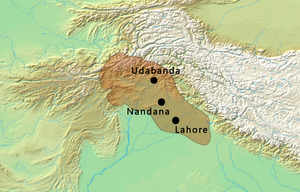
Back হিন্দু শাহী Bengali/Bangla Hinduixàhida Catalan Hindu-Shahi German شاهی هندو Persian हिन्दू शाही Hindi Shahi (regno) Italian हिन्दु शाही वंश Nepali ਹਿੰਦੂ ਸ਼ਾਹੀ Punjabi برہمن شاہی PNB هندوشاهي Pashto/Pushto
Hindu Shahis | |||||||||||
|---|---|---|---|---|---|---|---|---|---|---|---|
| c. 843 CE–1026 CE | |||||||||||
Location of the Hindu Shahis, and contemporary polities, c. 1000 | |||||||||||
| Capital |
| ||||||||||
| Religion | Shaivism | ||||||||||
| Government | Monarchy | ||||||||||
| Maharajadhiraja | |||||||||||
• c. 843 CE | Kallar | ||||||||||
• c. 850 CE | Samanta | ||||||||||
• c. 880 CE | Lalliya | ||||||||||
• c. 903 CE | Toramana | ||||||||||
• c. 921 CE | Bhimadeva | ||||||||||
• c. 964 CE | Jayapala | ||||||||||
• c. 1002 CE | Anandapala | ||||||||||
• c. 1010 CE | Trilocanapala | ||||||||||
• c. 1021 CE | Bhimapala | ||||||||||
| Historical era | Early Middle Ages | ||||||||||
• Established | c. 843 CE | ||||||||||
• Disestablished | 1026 CE | ||||||||||
| |||||||||||
| Today part of | Afghanistan Pakistan India | ||||||||||
The Hindu Shahis also referred to as the Uḍi Śāhis were a dynasty established between 843 CE and 1026 CE. They endured multiple waves of conquests for nearly two centuries and its core territory was described as having contained the regions of Eastern Afghanistan and Gandhara, encompassing the area up to the Sutlej river in modern day Punjab, expanding into the Kangra Valley. The empire was founded by Kallar in c. 843 CE after overthrowing Lagaturman, the last Turk Shahi king.
The history of the Hindu Shahis begins in 843 CE with Kallar deposing the last Turk Shahi ruler, Lagaturman. Samanta succeeded him, and it was during his reign that the region of Kabul was lost to the Saffarid empire.[2] Lalliya replaced Samanta soon after and re-conquered Kabul whilst also subduing the region of Zabulistan.[3][4] He is additionally noteworthy for coming into conflict with Samkaravarman of the Utpala dynasty resulting in his victory and the latters death in Hazara.[5] Bhimadeva, the next notable ruler, is most significant for vanquishing the Samanid Empire in Ghazni and Kabul in response to their conquests.[6] Jayapala then gained control and was brought into conflict with the newly formed Ghaznavid Empire, however, he was eventually defeated. During his rule his son and successor, Anandapala, conquered the kingdom of Lahore. The following Shahi rulers all resisted the Ghaznavids but were ultimately unsuccessful, resulting in the downfall of the empire in 1026 CE.
- ^ Schwartzberg, Joseph E. (1978). A Historical atlas of South Asia. Chicago: University of Chicago Press. p. 146, map XIV.2 (j). ISBN 0226742210.
- ^ Cite error: The named reference
:1was invoked but never defined (see the help page). - ^ Cite error: The named reference
:2was invoked but never defined (see the help page). - ^ Cite error: The named reference
:3was invoked but never defined (see the help page). - ^ Cite error: The named reference
:4was invoked but never defined (see the help page). - ^ Cite error: The named reference
:5was invoked but never defined (see the help page).
© MMXXIII Rich X Search. We shall prevail. All rights reserved. Rich X Search

